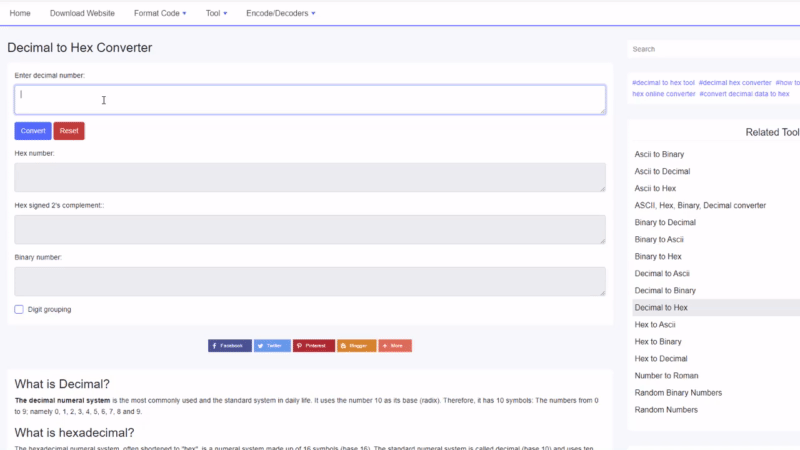What is Decimal?
The decimal numeral system is the most commonly used and the standard system in daily life. It uses the number 10 as its base (radix). Therefore, it has 10 symbols: The numbers from 0 to 9; namely 0, 1, 2, 3, 4, 5, 6, 7, 8 and 9.
What is hexadecimal?
The hexadecimal numeral system, often shortened to "hex", is a numeral system made up of 16 symbols (base 16). The standard numeral system is called decimal (base 10) and uses ten symbols: 0,1,2,3,4,5,6,7,8,9. Hexadecimal uses the decimal numbers and six extra symbols. There are no numerical symbols that represent values greater than nine, so letters taken from the English alphabet are used, specifically A, B, C, D, E and F. Hexadecimal A = decimal 10, and hexadecimal F = decimal 15.
Decimal to hex Example
Convert 2020110 to hex:
| Division by 16 | Quotient | Remainder (decimal) | Remainder (hex) | Digit # |
|---|---|---|---|---|
| 20201/16 | 1262 | 9 | 9 | 0 |
| 1262/16 | 78 | 14 | E | 1 |
| 78/16 | 4 | 14 | E | 2 |
| 8/16 | 0 | 4 | 4 | 3 |
So 2020110 = 4EE916
Decimal to hex conversion table
| Decimal base 10 | Hex base 16 |
|---|---|
| 0 | 0 |
| 1 | 1 |
| 2 | 2 |
| 3 | 3 |
| 4 | 4 |
| 5 | 5 |
| 6 | 6 |
| 7 | 7 |
| 8 | 8 |
| 9 | 9 |
| 10 | A |
| 11 | B |
| 12 | C |
| 13 | D |
| 14 | E |
| 15 | F |
| 16 | 10 |
| 17 | 11 |
| 18 | 12 |
| 19 | 13 |
| 20 | 14 |
| 21 | 15 |
| 22 | 16 |
| 23 | 17 |
| 24 | 18 |
| 25 | 19 |
| 26 | 1A |
| 27 | 1B |
| 28 | 1C |
| 29 | 1D |
| 30 | 1E |
| 40 | 28 |
| 50 | 32 |
| 60 | 3C |
| 70 | 46 |
| 80 | 50 |
| 90 | 5A |
| 100 | 64 |
| 200 | C8 |
| 1000 | 3E8 |
| 2000 | 7D0 |
